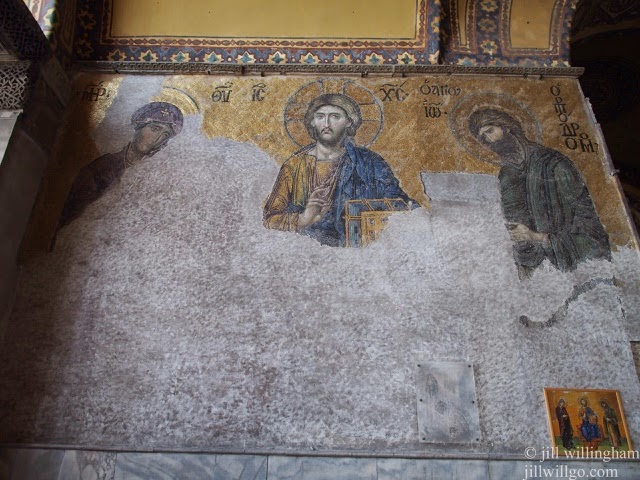Today I finally felt up to hitting the highlights of Istanbul. Began early with Aya Sofya (or Hagia Sophia). It was commissioned by the Byzantine Emperor Justianian, consecrated as a church in 537, then converted to a mosque in 1453, and finally declared a museum by Ataturk in 1935. Now it stands as a unique blend of east and west, Islam and Christianity, all folded into a simply stunning architectural wonder.
The interior contains mosaics that glow.
Massive doors lead to the nave. The main dome rises 185 feet and is roughly 105 feet in diameter.
In this picture, we see the name of Allah written on a huge wooden medallion (Ottoman additions in the 19th century), along with Mary and Jesus in the smaller dome.
Sadly, a lot of restoration is going on right now, so a lot of the space was taken up with scaffolding.
The amount of selfies taken here must be staggering. I spotted this sure fire technique for getting just the right shot of yourself.
Not only mosaics decorate the interior, there is also some beautiful tile work.
View from the upper gallery. I could get a sense of scale from this vantage point.
Another beautiful example of mosaics. If you want to see them, you should go now, because the inability of people to obey the "no flash" rule is ruining them a little bit every day. In my next bitchier life, I hope to return as someone whose job it is to scream at people who use their flash. I would enjoy that. Not only is turning off the flash the decent thing to do, but there are signs everywhere and people walking around saying, "No flash!" I actually saw one woman claim to not know how to turn it off (so we know that all of her pictures are bad), and the guard took her camera, adjusted it for her, gave her a stern look, and handed it back. If you can't get the shot without a flash, buy a fucking postcard or - random idea here, remember what you saw. Here ends the rant.
Outside of Hagia Sophia are the tombs of five sultans and some members of their families. One of them, Selim's tomb, contains him, and five of his sons who were murdered one night in 1574 to ensure the "peaceful" succession of his eldest son, Murad III. Nineteen of Murad's sons are buried here, too, because they were all murdered one day in 1595 to ensure another "peaceful" succession of his eldest son, Mehmet III. After this, the potential heirs (siblings) to the throne where allowed to live, but were confined in the Topkapi Palce instead. Whew. Pays to be the first born.
There was an attendant at the tombs who was on shoe patrol. "Shoes off!" "Photo ok!"
When I exited and was putting my shoes back on, he was closely watching a man who looked like he might be entering with his shoes on. The attendant made a loud "tsk, tsk!" noise, kind of like you would at a dog. The man looked at him and backed away from the door. We grinned at each other and I said, "Photos yes. Shoes, no." He nodded.
After all that gory family history, it was time to visit the atmospheric underground cisterns. This was a massive water reservoir (big enough to hold 27 million gallons) in 532. It was constructed with 336 columns some of which were salvaged from ruined temples (recycling!). The cistern was forgotten after many years, until a researcher in 1545 was told about the miraculous water coming from basements in Istanbul. Locals said that they could lower buckets into holes in a dark space under their houses and get water - and sometimes fish.
The cistern wasn't cleaned out until 1985 and was opened to tourists in 1987.
There are two recycled Medusa heads down here. Mysteriously placed upside down and sideways.
Then it was time for lunch. I went to a little neighborhood spot right around the corner from my hotel. It was delicious. Lentil soup, a full plate of chicken, tomatoes, onions, cabbage, and lettuce. All for just $7 - and that was with a tip. It was right on a busy corner, so I got to watch the stray cats, the traffic jams, the locals come in and out. I might have to return for dinner just to get more of those onions.
After lunch it was time to tackle the Blue Mosque. The mosque was completed in 1616. The six minarets are unique, probably requested by the sultan to showcase his wealth. The mosque is a functioning place of worship, so it is closed five times a day for prayer and visitors have to enter through a back entrance. The women are inspected for the appropriate dress - you are handed a sheet if you are deemed too skimpy. Scarves are a must, of course.
Tomorrow I leave Turkey. I feel like I only had a small taste of this interesting country.
I'll have to come back.
























Comments
Post a Comment